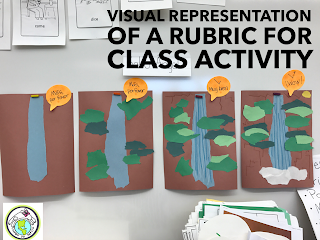SUPPORTING STUDENTS IN THE TARGET LANGUAGE is an important component throughout class, and across all activities-we all know this. But are we clearly communicating what our expectations are to our students? Do they know what constitutes 'meets' (in a 4 point rubric) for example? Do they know what 'Novice Mid' looks like/sounds like in a given activity? Providing a visual breakdown (or even audio breakdown in a video!) can be that powerful link that gives kids a strong understanding of the expectations and provides an opportunity for them to engage in their own reflection on their learning (aka student self assessment).
ESPECIALLY WITH MY ELEMENTARY STUDENTS, but certainly with ALL students, their understanding of expectations is frequently unclear if I don't provide an example, which, in my opinion, becomes quite unfair in an assessment situation. If you don't know what to shoot for, how do you really know what to do in the first place? One way to do this is to break down a rubric into it's elements and provide a visual representation of each so that kids know what constitutes a 1, 2, 3 or 4 (in a 4 point rubric where a 4 is 'exceeds').
THIS IS A RUBRIC I CREATED FOR MY FIRST GRADERS of our Salto Ángel collage activity, part of our theme on Venezuela. As you can see, I created an example of each level of the rubric so they could see EXACTLY what needed to be completed to get to '¡Muy bien!'. This representation also aids in keeping the class in the target language because if a student comes to me with 'I'm done' we can compare theirs to the visual rubric, and it becomes readily apparent whether they need to do more or not: I put the question back on them and THEY self assess by looking at the examples. We can then very simply process: Is yours like this? like this? like this? (see how simple the language is! #novice) I can then point to elements in the level beyond where they identify their work to indicate what they still need to do. Interestingly, when an example of a 4 is provided, I find more kids will shoot for that as opposed to if you only show up to a 3. Again, it's that idea of clearing up the mystery of what's expected and what can be achieved. Here's the link to a super simple video example of processing with a student-click here.
ONE WAY I REALLY LIKE TO TALK ABOUT movement along a rubric, and/or even where one is on the rubric continuum, is the hamburger rubric, which I morphed into a 'Taco rubric'. It is very kid friendly and envisions the rubric as progress from just getting started to achieving, without a 'gotcha' stance, and uses ordering in a restaurant as it's metaphor-I just LOVE it! You can read about it in my blog post here.
What types of rubrics do you use? I would love to hear about them in the comments below!




Hey, would you mind if I share your blog with my twitter group? There’s a lot of folks that I think would enjoy your content. Please let me know. Thank you.
ReplyDeleteJava Training in Chennai | J2EE Training in Chennai | Advanced Java Training in Chennai | Core Java Training in Chennai | Java Training institute in Chennai